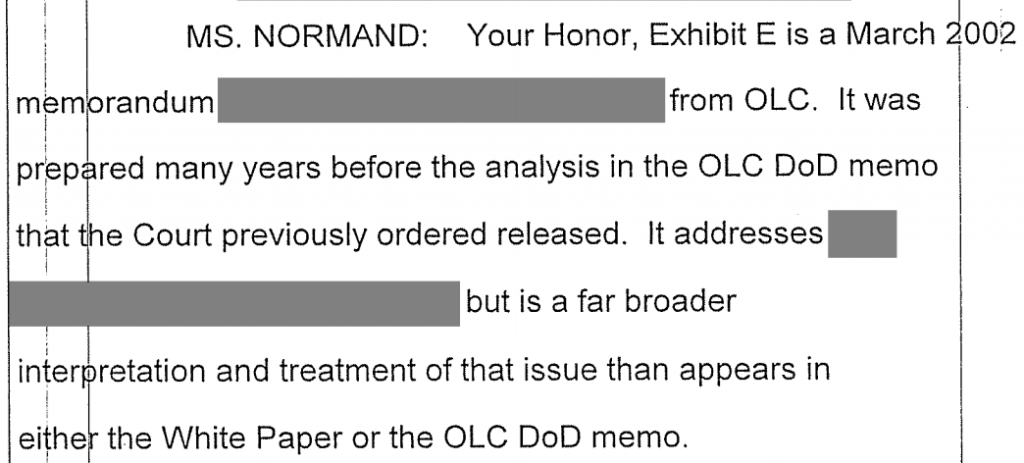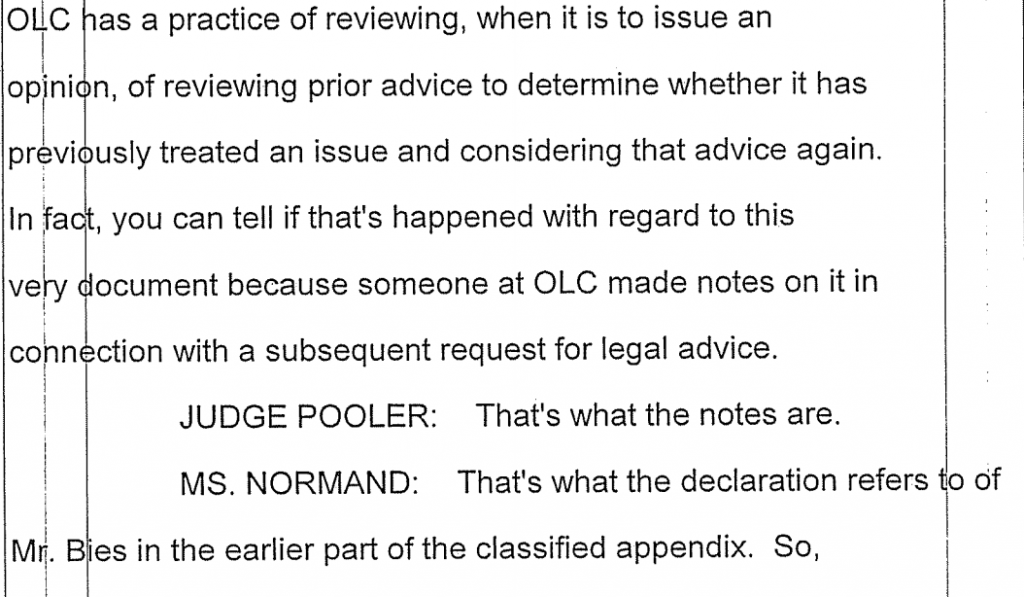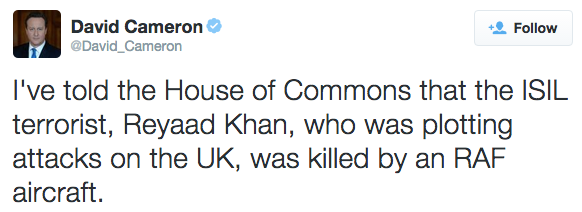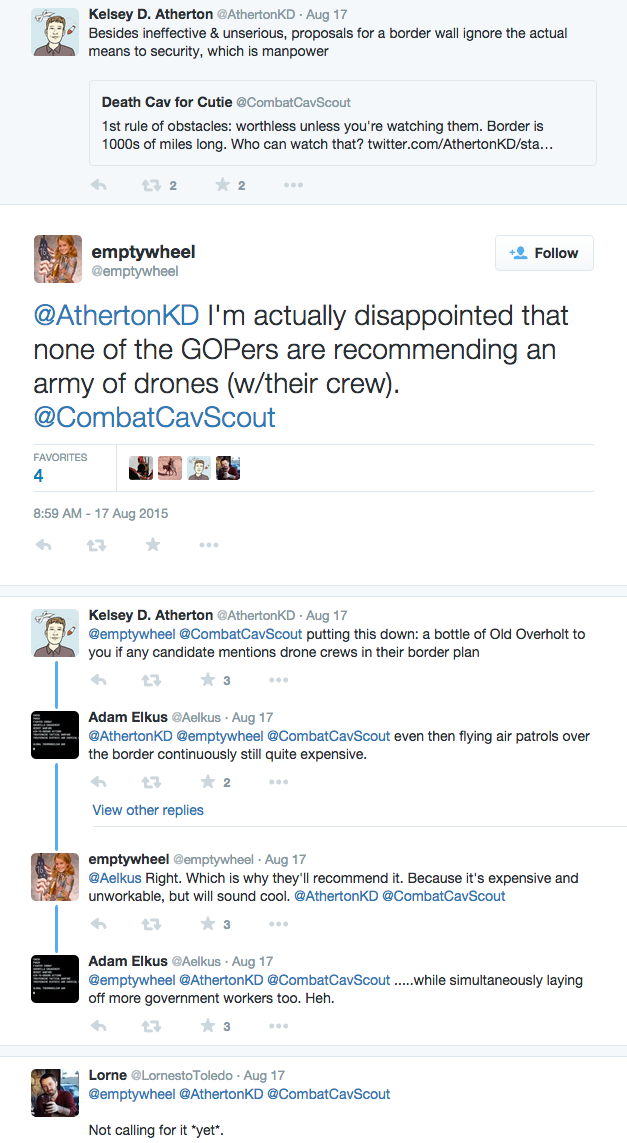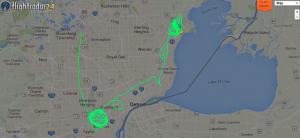Jack Goldsmith conducted fascinating interview with NYT Executive Editor Dean Baquet about the latter’s decision to name Michael D’Andrea and two other top CIA officials whose identities the CIA was trying to suppress.
He attributes his decision to three factors: The CIA has increasingly taken on a new military role that demands some accountability, the CIA admitted these three figures were widely known anyway, and the CIA (and NSA’s) explanations in the past have proven lame.
There are some interesting points, but I think Baquet — and Goldsmith — miss two aspects of accountability that the NYT article permitted.
Widely known figures
Baquet reveals that even the CIA didn’t claim these men were secret, even if it still pretends they are under cover.
DB: These guys may technically be undercover. But even the CIA admitted when they called – and this was a big factor in the decision – that they are widely known, and they were known to the governments where they were stationed. The CIA’s pitch was not that these guys are secret or that people don’t know about them. The CIA’s pitch to me was, “Look, its one thing to be widely known, and to be known to governments and to be on web sites; but when they appear on the front page of the New York Times, that has a larger meaning.” So they were known anyway. The gentleman at the very top [of the CTC] runs a thousand-person agency, and makes huge decisions, personally, that have tremendous repercussions for national security. I’m not making judgments about him, but that’s the reality.
Later in the interview Goldsmith appears to totally ignore this point when he worries that these men don’t have the same kind of security as their counterparts running drone programs in the military. He suggests they might come under new threat because their names have been published on the front page of the NYT.
But that assumes our adversaries are too dumb to look in the places where these men’s names have been published before — just like CIA’s successful attempt to suppress Raymond Davis’ association with the CIA even after it was broadly known in Pakistan. It assumes our adversaries who seek out this information are not going to find where it’s hiding in plain sight.
The CIA isn’t keeping these secrets from our adversaries. They already know them. Which makes CIA’s efforts to keep them from the US public all the more problematic.
Crying wolf
Baquet’s argument about CIA’s squandered credibility is two fold. First, he notes that the CIA always claims people are under cover, which makes their claims less credible as a result.
JG: Let me ask you a different question. What do you think about the claim by Bob Litt, the General Counsel of the DNI, that you’ve put these guys’ lives and their families’ lives in jeopardy, and also the people they worked with undercover abroad? How do you assess that? How do you weigh that?
DB: I guess I would say a couple of things. I wish the CIA did not say that about everybody and everything. They hurt their case.
JG: They say it a lot?
DB: They say it all the time. I wish they were a little more measured in saying that. Sometime it’s a little difficult to deal with the Agency. When somebody says that and has a track record of rarely saying that, it really gives me pause. But they [the CIA] say it whenever we want to mention a [covert] CIA operative or CIA official.
But — perhaps more importantly for a guy who has taken heat for killing important stories in the past — Baquet also mentions the times agencies convince him to kill stories that turn out to get published anyway. Baquet uses sitting on the detail that the US used a drone base in Saudi Arabia to kill Anwar al-Awlaki as his example.
DB: I’ll give you an example. When Al-Awlaki was killed by a drone strike, we were on deadline, and I was the Managing Editor. The Acting Director of the CIA called up because we were going to say in the middle of the story that the drone that killed Al-Awlaki took off from a base in Saudi Arabia. (I can give you twenty examples, but this is just one.) He called up and said, “If you say that the drone took off from a base in Saudi Arabia, we are going to lose that base. The Saudis are going to go nuts, they don’t want people to know that we are flying drones from their base.” And so I took it out. And I think we made it something like, “The drones took off from a base in the Arabian Peninsula,” something vague. Sure enough, the next day, everybody other than us said it was Saudi Arabia. When I thought hard about it, [I concluded] that was not a good request. And I later told the CIA it was not a good request. And they should have admitted that was not a good request. Everyone knew they had a base. It was for geopolitical reasons, not really national security reasons. I think that’s one where they shouldn’t have asked and I shouldn’t have said “yes” so automatically. So now I am tougher. Now I just say to them, “Give me a compelling reason, really really tell me.” Because to not publish, in my way of thinking, is almost a political act. To not publish is a big deal. So I say, “Give me a compelling reason.” And I don’t think I said that hard enough earlier on. That influences me now. It does make me want to say to the CIA, and the NSA, and other agencies involved in surveillance and intelligence: “Guys, make the case. You can’t just say that it hurts national security. You can’t just say vaguely that it’s going to get somebody killed. You’ve got to help me, tell me.” In cases where they have actually said to me something really specific, I have held it. There is still stuff that’s held, because it is real. But I think I am tougher now and hold them to higher standards. And part of that is that secrecy now is part of the story. It’s not just a byproduct of the story. It’s part of the story. I think there is a discussion in the country about secrecy in government post-9/11. It was provoked partly by Snowden, it was provoked partly by the secrecy of the drone program. And I think that secrecy is now part of it. And that puts more pressure on me to reveal details when I have them.
But I find his invocation of Snowden (and the mention of the NSA which he makes 4 times) all the more interesting.
Remember, in 2006, Mark Klein brought the story, with documents to prove the case, that the NSA had tapped into AT&T’s Folsom Street switch to Baquet when the latter was at the LAT. Baquet killed the story, only to have the NYT publish the story shortly thereafter.
Back in 2006, former AT&T employee Mark Klein revealed information that proved the communications giant was allowing the NSA to monitor Internet traffic “without any regard for the Fourth Amendment.” Klein initially brought the story to The Los Angeles Times, but it never made it to print under Baquet, who recently replaced the fired Jill Abramson as executive editor of The New York Times.
Klein told HuffPost Live’s Alyona Minkovski that he gave 120 pages of AT&T documents to an LA Times reporter who “was promising a big front-page expose” on the story. But the reporter eventually told Klein there was a “hangup,” and the story was abandoned shortly after with no explanation.
Months later, producers from ABC’s “Nightline” who were working on the story contacted editors at the LA Times to ask if they had, in fact, decided not to print it. The producers were told that Baquet killed the story, Klein said.
“That’s when Dean Baquet came out with this lame excuse that he just couldn’t figure out my technical documents, so he didn’t think they had a story. I don’t think anybody really believed that argument because, as I said, a few weeks after the LA Times killed the story, I went to The New York Times and they had no trouble figuring it out,” Klein said.
Any question of the clarity in the documents Klein produced “was just Dean Baquet’s lame cover story for capitulating to the government’s threats,” Klein alleged.
And while Baquet still claims he didn’t kill the story due to pressure from the government, the claim has always rung hollow.
The CIA and NSA have not only cried wolf once too often, they have cried wolf with Baquet personally.
Missing accountability
There are two things that are, sadly, missing from this discussion.
First, no one actually believes that Michael D’Andrea, who (as I pointed out yesterday) the CIA helped Hollywood turn into one of the heroes of the Osama bin Laden hunt) is really under cover. But it’s important to look at what suppressing his actual name does for accountability. And the torture report is the best exhibit for that.
If you can’t connect all the things that D’Andrea — or Alfrea Bikowsky or Jonathan Fredman — have done in their role with torture, you can’t show that certain people should have known better. After KSM led Bikowsky to believe, for 3 months, that he had sent someone to recruit black Muslims in Montana to start forest fires, any further unfathomable credulity on her part can no longer be deemed an honest mistake; it’s either outright incompetence, or a willful choice to chase threats that are not real. Hiding D’Andrea’s name, along with the others, prevents that kind of accountability.
But there’s one other crucial part of accountability that’s core to the claim that our representative government adequately exercises oversight over CIA.
A key part of the NYT story (and Baquet emphasized this) was challenging whether the Intelligence Committees were exercising adequate oversight over the drone strikes. The NYT included really damning details about Mike Rogers and Richard Burr pushing to kill Americans.
Yet the article was most damning, I think, for Dianne Feinstein, though it didn’t make the case as assertively as they could have. Consider the implications of this:
In secret meetings on Capitol Hill, Mr. D’Andrea was a forceful advocate for the drone program and won supporters among both Republicans and Democrats. Congressional staff members said that he was particularly effective in winning the support of Senator Dianne Feinstein, the California Democrat who was chairwoman of the Senate Intelligence Committee until January, when Republicans assumed control of the chamber.
[snip]
The confidence Ms. Feinstein and other Democrats express about the drone program, which by most accounts has been effective in killing hundreds of Qaeda operatives and members of other militant groups over the years, stands in sharp contrast to the criticism among lawmakers of the now defunct C.I.A. program to capture and interrogate Qaeda suspects in secret prisons.
But both programs were led by some of the same people.
The implication — which should be made explicit — is that Dianne Feinstein has been protecting and trusting a guy who also happens to have been a key architect of the torture program (Feinstein did the same with Stephen Kappes).
Feinstein can complain about torture accountability all she wants. But she has the ability to hold certain people to a higher standard, and instead, in D’Andrea’s case and in Kappes, she has instead argued that they should maintain their power.
And that’s the kind of the thing the public can and should try to hold Feinstein accountable for. Rogers and Burr, at least, are not hypocrites. They like unchecked and ineffective CIA power, unabashedly. But Feinstein claims to have concerns about it … sometimes, but not others.
The public may not be able to do much to hold the CIA accountable. But we can call out Feinstein for failing to do the things she herself has power to do to get accountability for torture and other CIA mismanagement. And that, at least, is a key value of having named names.

